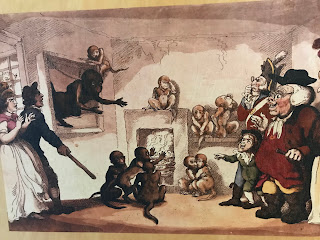In 1609 a bear ate an unattended child. As punishment, that noble and sage king, James I, ordered that the bear should be made to fight one of the royal lions. However, much to the king’s chagrin, neither animal showed any inclination to fight. and so the offending bear was instead baited to death by large hungry hounds. Tickets were sold and the grieving mother of the careless child was offered a cut of the profits in recompense.
The menagerie grew larger with the addition, in 1622, of three eagles, two pumas, a tiger and a jackal. This on top of the obligatory leopards and lions. The diarist, Samuel Pepys, was very fond of one old, very tame lion called Crowley. Not every lion was so tame; lions have their ‘off days.’ In 1686 a servant of the Keeper, Mary Jenkinson, stroked one of the lion’s paws and her arm was torn off:
‘Suddenly he catched her by the middle of the arm with his claws and mouth and most miserably tore her Flesh from her Bone, before he could be unloosed, notwithstanding that they thrust several lighted torches at him.’ The unfortunate girl had her arm amputated and died two days later.
By the C18th the Menagerie had become a major attraction, the ‘Monkey House’ in particular—until a boy was mauled by an over enthusiastic ape and, in consequence, the monkeys were put back in their cages.
After years of decline, the Menagerie enjoyed a final but brief flare of popularity when in 1822 an able and enthusiastic zookeeper was put in charge. Alfred Cops had a mission, immediately setting upon a programme of expansion, even travelling the world himself in search of new and exotic species. Within six years 300 animals from 60 countries were housed in the Tower’s Menagerie.
The kangaroos were a huge success, as too was Old Martin, the Tower's first Grizzly Bear donated by the Hudson Bay Company in 1811. It was a gift to George III who graciously said he would rather have been given a new tie or a pair of socks. Old Martin died in Regent's Park Zoo in 1838, presumably miffed that the king would have preferred socks. It is interesting to note though that his ghost still lingers in the Tower, along with that of Anne Boleyn, presumably appearing on different nights.
Though Cops was both knowledgeable and kind, the animals remained housed in cramped conditions – with sometimes unfortunate results. An inquisitive secretary bird had its head torn off when it peered into a hyena’s cage.
Other significant changes took place in the 1820s. The RSPCA, founded in 1824, highlighted some of the cruelties long taken for granted. In 1826, the Duke of Wellington, hero of Waterloo, was appointed Constable of the Tower. Being a military man, he couldn’t be doing with animals. For him, the Tower was a military operation. He was a soldier, not a zookeeper. In 1828, 150 of the animals were rehoused in the new zoo at Regent’s Park.
A desperate Cops reduced the entry fee for his now depleted menagerie, but fate took a hand again. An escaped wolf almost devoured a child, and a monkey bit a guardsman’s leg. In 1835 King William IV closed the Royal Menagerie for good.
Now, as a reminder, a few sculptures peer menacingly at visitors, and there are the ravens of course, a far cry from the Menagerie’s golden age.


2 comments:
I think the only blessing is that none of those animals had to live long. What a miserable existence.
Wholeheartedly agree, Maria. But that's history , the squalid and brutal sliming through the inspired and profound.
Post a Comment